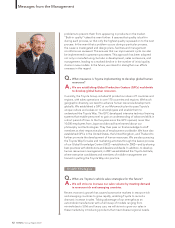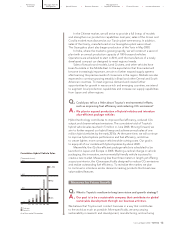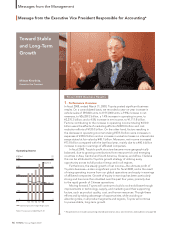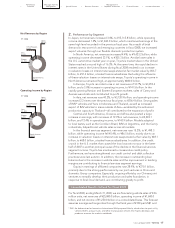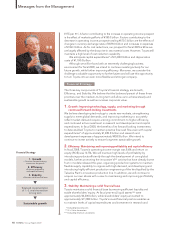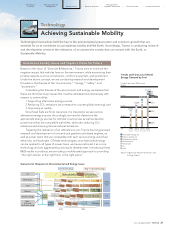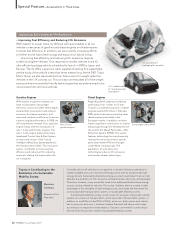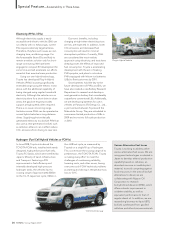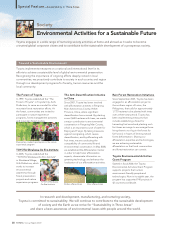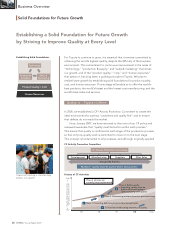Toyota 2008 Annual Report Download - page 24
Download and view the complete annual report
Please find page 24 of the 2008 Toyota annual report below. You can navigate through the pages in the report by either clicking on the pages listed below, or by using the keyword search tool below to find specific information within the annual report.
22 TOYOTA •Annual Report 2008 •
Special Feature—Sustainability in Three Areas
»Improving Fuel Efficiency and Reducing CO2Emissions
With respect to power trains, by 2010 we will have installed in all our
vehicles a new series of gasoline and diesel engines and transmissions
to boost fuel efficiency. In addition, we are currently increasing efforts
to further evolve hybrid technology and expand our hybrid lineup.
Improving fuel efficiency and reducing CO2emissions requires
smaller and lighter vehicles. One response to smaller vehicles is the iQ
ultra-efficient package vehicle, scheduled to launch in 2008 in Japan and
Europe. The iQ offers a spacious cabin capable of seating four passengers,
yet the body of the vehicle is less than three meters long. At the 2007 Tokyo
Motor Show, we also demonstrated our future vision for weight reduction
vehicles in the 1/X concept car. This concept car embodies all of the weight-
saving and environmentally friendly technologies that we believe need to be
incorporated into all future vehicles.
Improving Environmental Performance
Gasoline Engines
With respect to gasoline engines, we
have incorporated cutting-edge
electronic control and other technologies,
lowered fuel consumption and exhaust
emissions for cleaner operation, and
improved combustion efficiency to ensure
superior engine performance. In 2008, we
will complete the renewal of our gasoline
engine lineup with the introduction of
new 1.3-liter and 2.5-liter engines. The
new 1.3-liter engine features the newly
developed Toyota Stop & Start System,
an improved version of the Toyota
Intelligent Idling Stop Systemapplied to
the Vitz launched in 2003. This innovative
system contributes to improving fuel
efficiency and reducing CO2output by
automatic stalling the engine when the
car is stopped.
Diesel Engines
Regarding diesel engines, providing a
wide lineup from 1.4-liter to 4.5-liter,
Toyota’s cumulative production of diesel
engines reached 20 million in February
2008, while it has been promoting clean
diesel engines particularly in the
European market. In addition, we have
made a significant contribution to cleaner
exhaust gas through the development of
the world’s first Diesel Particulate—NOx
Reduction System (DPNR). This system
features technology that simultaneously
reduces the emissions level of specific
particulate matter (PM) and nitrogen
oxide (NOx) in exhaust gas. The
application of such advanced
technologies reduces CO2emissions
and ensures cleaner exhaust gas.
Toyota is Contributing to the
Realization of a Sustainable
Mobility Society
Masatami
Takimoto
Executive Vice
President
Currently, almost all vehicles run on gasoline or diesel oil because petroleum is
readily available and is an economical energy source with an exceptionally high
energy density. Sustainable alternative energy sources to petroleum that can help
alleviate the problems of CO2emissions include biofuels, electricity, and hydrogen.
There are, however, many issues that need to be addressed before these energy
sources can be utilized for vehicles. This is why, I believe, there is a need to take
advantage of the strengths of each energy source, and create the framework for
a new sustainable transportation system, or Sustainable Mobility society.
A Sustainable Mobility society could consist of new types of personal mobility
systems as a means of transportation, and a new public transportation system, in
addition to small EVs, biofuel PHVs, FCHVs, and so on. Each system and vehicle
has its own pros and cons. I, however, believe that each will have a role to play
according to its respective characteristics. Toyota is committed to continuing to
devote its full resources to realize a Sustainable Mobility society.
New 2.5-liter
gasoline engine
Diesel engine with a DPNR
iQ, ultra-efficient
packaging like no other
1/X, a redefinition
of “environmentally
considerate”


